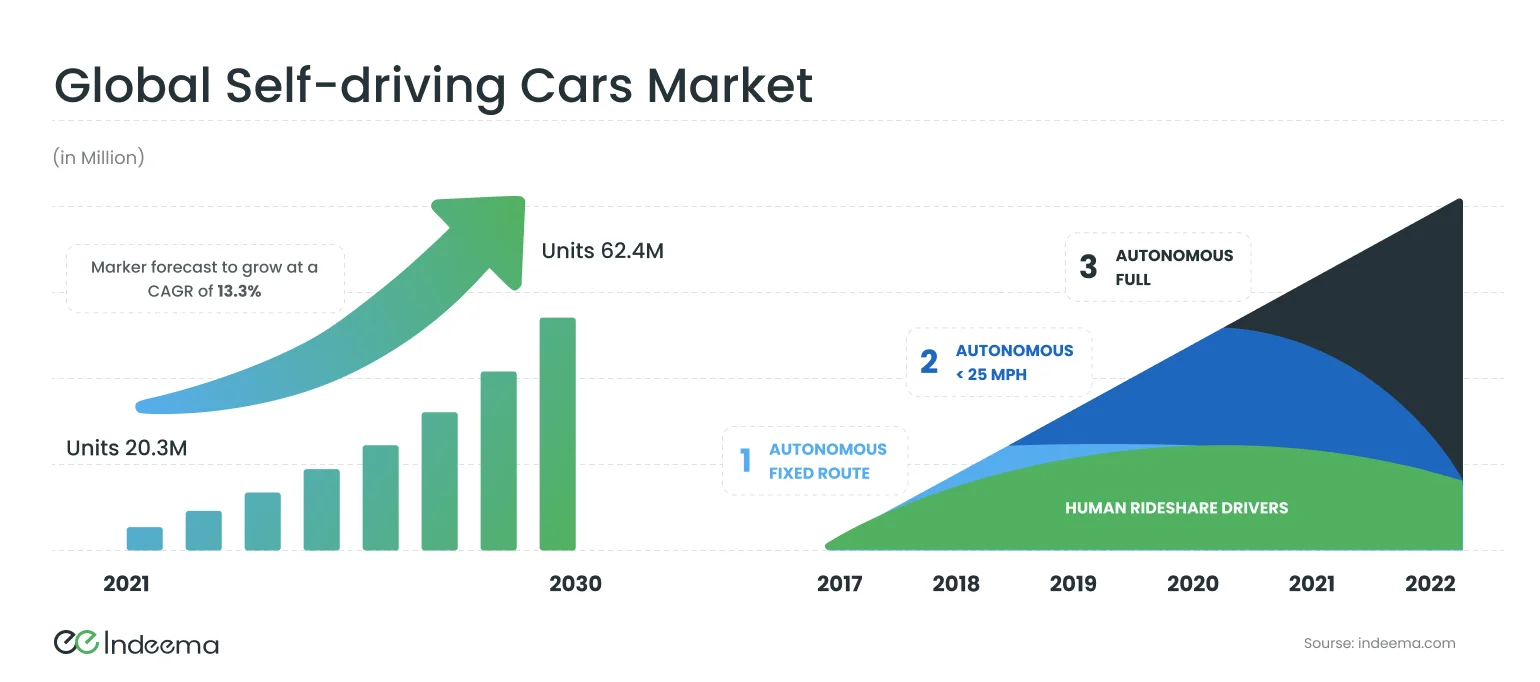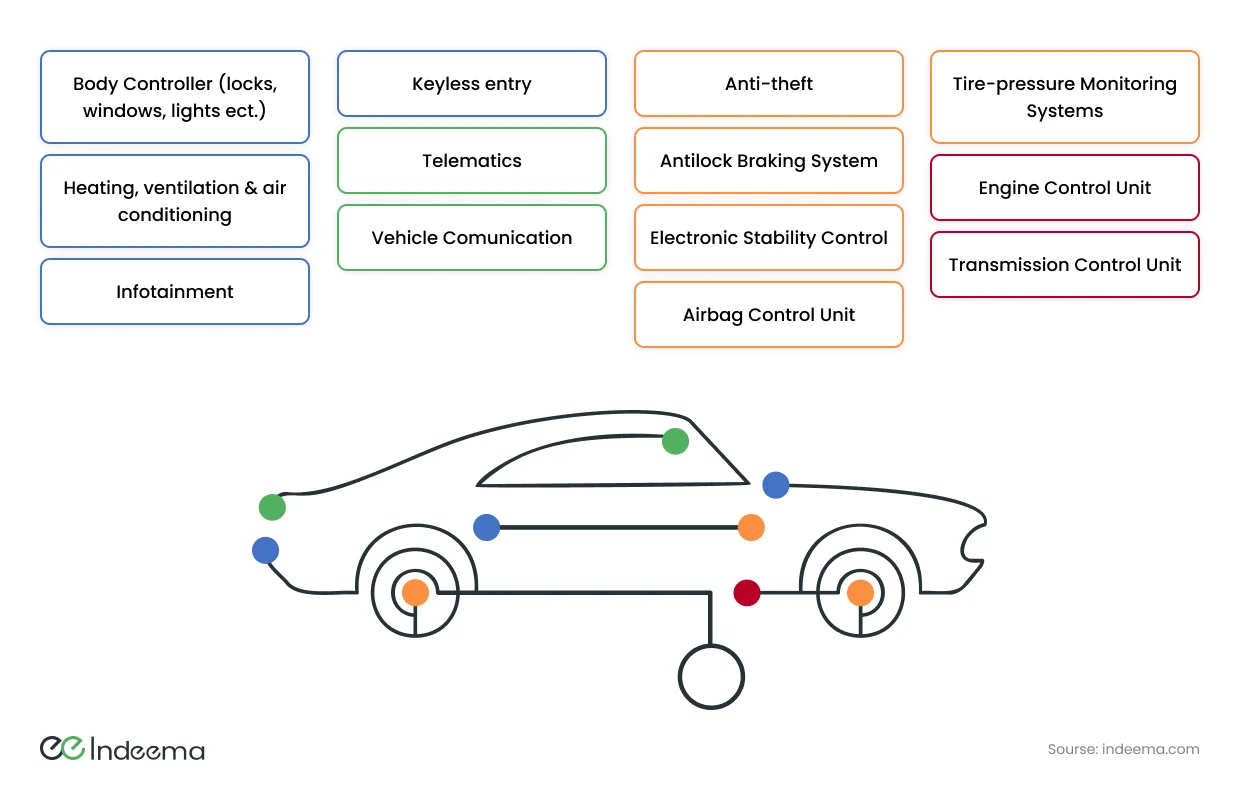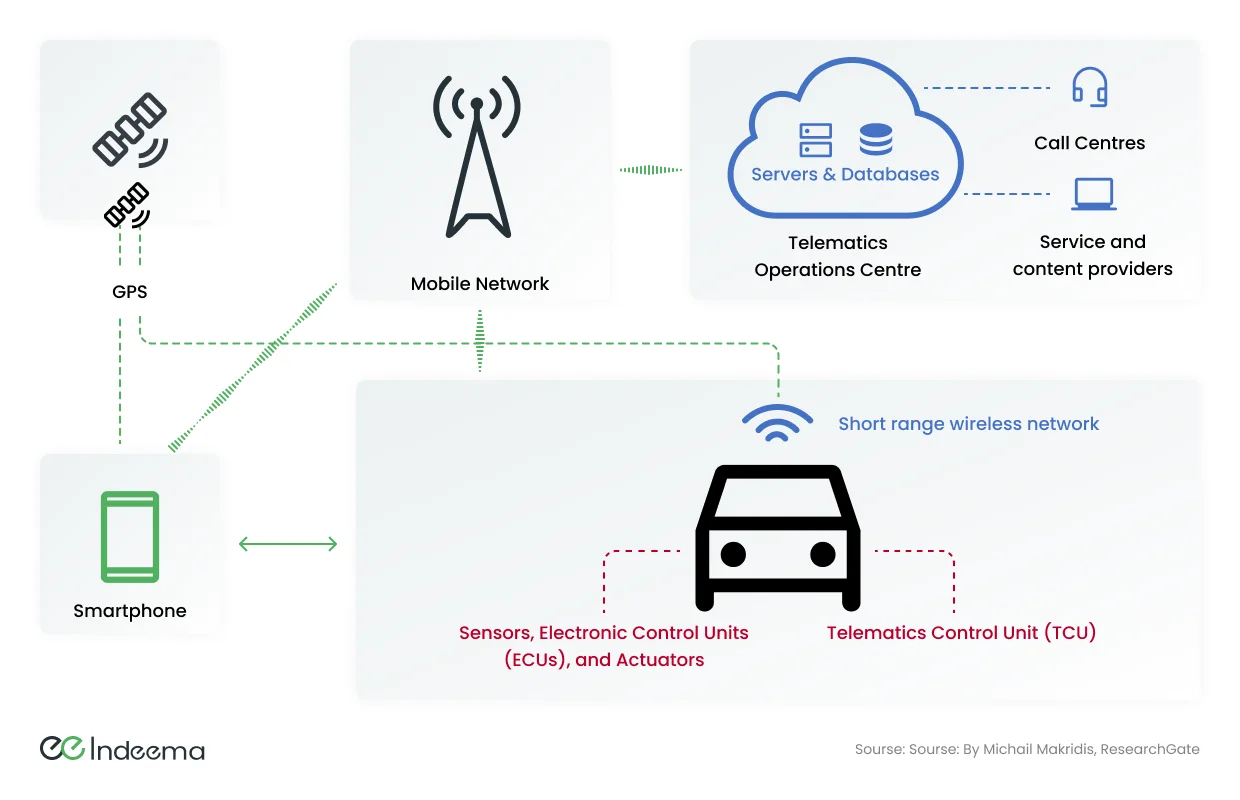Introduction
Competition is high in the automobile market as its worth exceeds $2.95 trillion as of 2022. Manufacturers that want to succeed in this industry need to think forward to predict and meet the needs of their customers.
The fact is that basic transportation capabilities are no longer adequate for the average IoT car owner. They expect added intelligence in the form of connected vehicles equipped with IoT features. It is projected that by 2025, there will be over 400 million connected cars in operation, up from some 237 million in 2021.
The Internet of Things (IoT) has quickly become the norm, with applications ranging from virtual assistants to smart home gadgets. Autonomous vehicles are one of the most rapidly expanding categories of IoT products, offering innovative and advanced solutions like Advanced Driver-Assistance Systems (ADAS), navigation & telematics, in-vehicle infotainment, IoT Automotive applications, predictive maintenance and much more. It's evident that IoT is all set to have a revolutionary impact on the automotive sector.

The global market for autonomous automobiles is expected to grow to 62.4 million units in 2030 from 20.3 million units in 2021 at a CAGR of 13.3%. Preference for driver assistance systems and strict safety standards to create a safer driving environment are key factors propelling this growth.
Expect automobiles to develop the intelligence to recognize and react to their immediate surrounding environment and share relevant data about their mechanical health and surroundings.
So there's a lot of room for development in this sector. If you're planning to contribute to this industry with an innovative IoT automotive program, first learn the ins and outs of IoT software development and how it can enhance your vehicles.
1. The Potential and Challenges of Smart Automotive
Imagine a traffic jams where your car could exchange information with the other vehicles nearby, allowing them to spread out and reduce congestion.
Can you imagine a world where your car could make payments at drive-throughs and smart parking lots without you having to lift a finger? Everyone with a vehicle may relate to these issues, so any new traffic management systems that eliminates them would be greatly appreciated.
However, how can we be confident that all data generated by our smart automobiles will be managed securely and privately? IoV technology industry leaders are likely to be the first collaborators in the Internet of Cars' implementation, given the urgency with which automakers are working to introduce their smart vehicles online.
Customers who are sick and tired of having their information sold or stolen may view this as grounds for alarm. Although major tech firms aren't inherently wrong, their business models are designed to put profits over customers' right to privacy and security.
It's not hard to foresee a potentially disastrous future for the Internet of Cars if things are not done right. Location-based ads update in real-time on your windscreen. These require you to give out sensitive information, like your driving habits. This data is saved on remote servers where it may be subjected to a host of new security holes. And that is one of the biggest potential challenges of connected vehicle technology.
So, let's figure out how to connect cars to the Internet in a way that reduces friction in our daily lives without creating wholly new issues.
2. What Functions Make Up The Computing Power Of Automobiles?
The modern customer sees a car as an innovative and safe means of transportation, an entertainment center, and a work tool. There must be enough computing resources to implement multimedia and smart functions of the IoT in cars.
However, the IoT automotive industry has many requirements for electronics, such as reliability, limitation of power consumption and electromagnetic radiation, size, etc., so conventional CPUs cannot be integrated into a vehicle.

2.1 Under the Hood Electronics: Electronic Control Units (ECU)
The Electronic Control Units (ECUs) are the backbone of the automobile's electronic system. A dedicated CAN data bus links all of the ECUs together to form the vehicle's internal network. The gearbox, engine, brakes, and airbag system are the four critical functional nodes intended to govern and automate. Driver and passenger safety hinges on these blocks. Therefore, they must be completely reliable.
Therefore, ECUs are tested on special stands under the most challenging conditions before integration into the car system: high overloads, vibration, and high and low temperatures (often -40 to 165 °C, the limit for electronics in general).
Due to the harsh conditions for electronics, the ECU's foundation is microcontrollers, built exclusively on proven technologies and technical processes.
On the other hand, modules have specific tasks that do not require high computing performance.
Most ECUs have one or two built-in processors with frequencies of 40–300 MHz and a small amount of RAM and flash memory. Such performance is sufficient for essential functions, but it will not be enough for the multimedia capabilities that the customer expects when he hears about IoT in the automobile industry.
2.2 Infotainment Solutions In Cars
The buyers of a brand-new vehicle expect, and often demand, a novel experience that keeps updating and surprising them in new ways, not just the first drive. They're interested in trying out the experimental new functions that will be made available as downloadable applications (Apps) or premium add-on services.
People want to remotely control additional car functionality at their fingertips, just like they control a smartphone. Most connected vehicles already have a built-in touch display, support hands-free calling, offer on-demand music, and have smart navigation functions.
The car also needs access to the Internet to operate interactive applications that perform such tasks as smart navigation or playing music.
Of course, you must integrate the onboard infotainment systems with other smart devices, primarily smartphones. Therefore, it must have all the standard internet connectivity options.
Modernity necessitates features that make it easier for the driver to operate the car and its peripheral systems, like the audio and climate controls and the central control unit.
2.3 Car Centralized Computers
Manufacturers of embedded automotive electronics have been developing and implementing units for various functions for a long time. Complex subsystems for providing drivers with data and entertainment, such as advanced driver assistance systems (ADAS), offer more challenges for people who create automobile semiconductors.

A powerful central computer needs to provide a set of smart and multimedia functions. And given that self-driving cars are gradually becoming mainstream, their computer systems must become more and more sophisticated.
Such a transition to a centralized computing architecture changes the car's internal systems and affects the IoT automotive industry as a whole.
The core value of the final product is shifting to semiconductor and software companies. And car manufacturers and suppliers who cannot adapt to new trends could suffer eroding profit margins.
3. How to Program Automotives for Efficiency and Convenience?
The availability of developing automotive software expands beyond the realm of highly specialized businesses. The gap between cars and mobile ecosystems is getting smaller and smaller.
3.1 Automotive Embedded Software
Software is a consistent component of IoT in automobiles. Therefore, software development places certain requirements on programmers.
- Developers must possess particular expertise because the IoT solutions must be integrated with the onboard computer of the car, frequently with specialist equipment.
- Security concerns and access control issues require special attention, so there are strict requirements for the quality of the software code, its performance, and its compatibility.
- Automotive software testing is required at several stages: testing in a virtual environment, laboratory testing on a model or real car, and testing on the road.
- The software's ease of use is also fundamental because the driver must operate the software without being distracted from driving, so the icons of the graphical interface must be large and native, and it must be possible to control via voice commands or mechanical buttons.
3.2 Technologies Behind Carplay and Android Auto
The leading software platforms for IoT in the automobile industry are the developments of the two most prominent software vendors for portable electronics - Apple and Google.
The solutions have some differences because CarPlay is a built-in feature of the iPhone, while Android Auto looks like an additional application. But both platforms aim to transfer smartphone functions to the car's standard display, letting you control certain vehicle functions using built-in buttons (for example, on the steering wheel) or a voice assistant.
The car's media system becomes an extension of the smartphone, allowing you to play music, answer calls, and control other functions using Siri or Android Assistant.
CarPlay and Android Auto take the experience of interacting with a smartphone behind the wheel to a new level. They improve advanced safety features by reducing the likelihood of distraction from the automotive development processes and standards.
The complexity of automotive software is increasing at an accelerated rate. This especially applies to the modules responsible for media functions and ADAS. The old approaches no longer work.
Software industry practices, such as agile development and simultaneous software and hardware development, hold the key to fixing the problem.
However, the Software Reliability Association (MISRA) and the Automotive Open System Architecture (AUTOSAR) are the two most necessary standards for generating code in the IoT automotive industry. To guarantee the quality and data security of the software code, they govern, among other factors, the standards for writing any code in the C/C++ language.
ISO 26262 governs safety and quality in general, whereas Automotive Safety Integrity Standards (ASILs) govern the safety of vehicles. Software safety, security, and dependability are all improved when developers adhere to standards.
4. How Does Car Connectivity Work
Despite the rapid development of sophisticated driver-assistance and autonomous driving key technologies, fully driverless vehicles won't be available anytime soon. However, the Internet of Things (IoT) already allows for substantial improvements in vehicular safety.
With the help of IoT, cars may now communicate with each other and the infrastructure around them.
4.1 Sophisticated vehicle RF technologies
The future isn't far when all cars on the road will be wirelessly connected, creating the "internet of vehicles." All current radio frequency (RF) technologies, including cellular (5G), Wi-Fi, Bluetooth, and NFC, are supported in today's automobiles.
However, connected vehicles IoT has its own specifics and difficulties, as in other cases.
⚈ Wireless modules must withstand the harsh conditions inside, including high heat and humidity.
⚈ Automotive modules would have a longer lifespan than their smartphone counterparts because a vehicle's useful life span can be more than ten years.
⚈ Engineers must find ways to prevent interference between the car's many radios by designing appropriate filters.
Using connected vehicle technology that has been tried and true on other devices is the best way to prevent most issues.
4.2 TCU and IoT: Principles and Use Cases
A stable connection is necessary for the car's operation. ECUs collect data about the vehicle's state from all parts, which is then transmitted to the Telematics Control Unit (TCU) for storage.
The TCU communicates with the IoT Cloud Server, which sends data for storage and processing. We can single out several special options for using TCU and Internet of Vehicles:
4.2.1 Remote diagnostics of cars
Continuous monitoring of vehicle parameters helps to know about an accident immediately and automatically notify the relevant rescue emergency services if necessary.
4.2.2 Prediction of malfunctions
Data collected in the cloud and artificial intelligence algorithms help predict connected car malfunctions based on subtle signs that are invisible to humans. A timely diagnosis can save lives.
4.2.3 Fleet management
Telemetry data and IoT in cars ensure optimization of logistics, routes, and fuel consumption. Managers can more effectively manage large fleets, monitor vehicles, and supervise drivers.
4.2.4 Insurance
Companies evaluate driving quality parameters and vehicle conditions based on the collected data and can reduce the prices of insurance policies.
 In fact, the broad range of automotive telemetry data is also helpful in other situations, such as evaluating the general dependability of cars and optimizing and improving individual components and software.
In fact, the broad range of automotive telemetry data is also helpful in other situations, such as evaluating the general dependability of cars and optimizing and improving individual components and software.
5. What To Consider When Developing An Automotive IoT App
It's critical to adhere to a few requirements to create a successful application of IoT in the automobile industry. Here are some of those requirements:
⚈ A team with developers familiar with the subject area. They must understand what data is, where and why it comes from, and how and what to manage.
⚈ Adherence to standards is not an empty sound. The safety and reliability of the software and hardware of the connected car should always be a priority.
⚈ Emphasis on uncompromising convenience for the user and using voice commands. The driver must concentrate on the road. Maybe it is better to use mechanical buttons instead of a touchscreen for some functions.
⚈ Whenever possible, use agile development methods to speed things up.
Conclusion
The Internet of Things has profoundly affected the automotive industry, leading to a reevaluation of the automobile as a concept. Today's drivers anticipate a fully functional software platform with advanced features like autonomous driving and simplified control and interaction.
Autos can now be better maintained and inspected using the Internet of Things and have access to more entertainment options. Auto telematics' ability to send data over great distances has also contributed to the IoT-based fleet management system currently in development.
Every day, more and more software is developed for the automotive industry. As IoT evolves, more complex use cases for automobiles will emerge, changing our fundamental relationship with vehicles.
Integrate IoT in Automotives with Indeema
Indeema's IoT development team is here to help if you've been thinking about making an IoT app for cars and want to be at the forefront of the digital transformation of the automotive industry.
Our team will also be happy to help if you encounter any problems. We will be the first to help you with anything and implement any solution, no matter how complicated. Check out our expertise in Automotive Industry now to get in touch with us!


